Camera flashes on or off camera size and shape
Aug 7, 2020 13:07:00 #
Rectangular flashes attempt to give light in a 1 flash setup in the direction needed to fill frame the of a 3X2 sensor and have the shadow fall behind the subject. However, simply rotating the camera for a vertical shot leaves the shadow to the side of the subject. Simply using a flash bracket that swivels rotates the flash back over the camera in the "portrait" orientation and the shadow back behind the subject, but the coverage is perpendicular to the sensor frame. A round flash doesn't care about orientation.
Of course, some brackets overcome the orientation problem and they need not be expensive.
Of course, some brackets overcome the orientation problem and they need not be expensive.
Aug 7, 2020 13:21:24 #
rehess wrote:
This first electronic flashes were oriented in a vertical way while 35mm frames were horizontal; once they got that straightened out, on-camera flashes have tended to match the camera frame. Off-camera flashes are a completely different story.
If you can find a working sample of those typical “vertical” electronic flashes, use it to shoot a blank wall with a 20mm lens. You’ll find out it’s not vertical at all. The little flash tube is vertical but its reflector design provides waaaaaay more spread horizontally than vertically.
The tall narrow form factor is problematic if you need to add a “hinge” for bounce flash, so the tall shape was doomed when flashes began offering more features.
Aug 7, 2020 13:41:43 #
amfoto1
Loc: San Jose, Calif. USA
dyximan wrote:
I Realize These are very general question and depe... (show quote)
There is not much difference between round and rectangular flashes.
Generally speaking, the round ones are more powerful. They are sort of like small, portable studio strobes. The round part you are seeing is basically just a diffuser. The flash tube behind it might be any shape... wound, half moon, straight. Some of the round flashes are designed to work with powerful external battery packs, to give a lot more shots than is possible with AA. Some of the more advanced and powerful "standard" flash have means of using an external power source, too. External, supplementary power sources also can make for faster flash recycling.
A more "standard" rectangular flash simply doesn't have a diffusion panel installed in front of the tube. You can use it that way, or... in many cases... you can add some sort of light shaping and diffusing device to the front of it, if you wish. These can give your images somewhat different "looks". If buying this type of flash and planning to use a modifier on it, be sure to check what's available. For some popular brands and models there are a lot of accessories being made. But for more obscure brands, it might be difficult to find good fitting accessories or require you to do some adapting to make something generic work. Heck, I've been known to use some white gauze bandage held on with a rubber band to diffuse a flash's output. Works great. Add layers to reduce output, such as when using a standard flash for close-up work where it would otherwise be too powerful.
Some "standard" flash have a built in "zoom" feature, that probably won't be found on any of the round ones. Essentially, this is a small Fresnel lens that sits in front of the flash tube, that's repositioned closer to or farther from the light source to widen or narrow the light output from the flash, so that it's coverage best matches the angle of view of the lens that's being used. There have been manual implementations of this (Vivitar 285 is one example that comes to mind).... and there are more advanced automatic versions (Canon 550EX and 580EX II flashes I use). Typically this allows adjustment for lens in the 24mm or 28mm focal length to 100mm or 105mm range. My Canon flash also have a little built-in panel that can be manually installed to make the flash work with even wide lenses in the 16mm to 17mm range (in all these cases, I'm referring to focal lengths on "full frame"... so make allowances if using on cameras with smaller or larger format sensors where the angle of view of any particular focal length will differ).
I sometimes use an accessory Flash Extender, which is basically just a more extreme version of the built in "zoom" lens on some flash. This mounts a larger Fresnel about 8 or 10 inches in front of the flash, to further narrow the light beam and give the flash more reach. I use it for wildlife and occasionally for sports, when shooting more distant subjects with a telephoto lens. In fact, the shortest lens that can be used with it is 300mm (or around 200mm on APS-C cameras).
There may be similar accessories for the "round" type of flash. I haven't really looked into it. Any flash with a diffuser would need for that to be removable, for these othoer sorts of accessories to be substituted.
Either type of flash should work fine for your purposes. The round type are popular with event photography pros, i.e. for portraiture.
For the night photography use you mention, you need to be able to set the flash to 2nd curtain sync. Be sure to check that your camera and the flash are both able to do this. Below is an example where I used 2nd curtain fill flash with a fairly slow shutter speed while panning with the subject (i.e. "dragging the shutter)...

Notice the "ghosting" that suggests forward (right to left) movement in this image. If I hadn't used 2nd curtain sync, if I'd used standard 1st curtain sync, that ghosting would be on the opposite side and would have made the subjects appear to be moving backward! Standard 1st curtain sync means the flash fires when the shutter first opens. 2nd curtain sync delays the firing until just before the shutter closes. It doesn't matter when subjects aren't moving.... but makes a difference when they're moving and you're using a slower shutter speed (if I recall correctly, 1/30 in the above example).
The round flash also tend to be more expensive, I've noticed. For example, the Quantum Q-Flash and Profoto A1X flash are each around $1200, though that includes a large, rechargeable power supply. In comparison, large flash such as top-of-the-line Canon 600EX-RT costs $450 or Nikon SB-5000 sell for $600. There are similar from third party manufacturers for $200 or less.
BTW, I think I was wrong when I wrote above that the round flash are more powerful! I just compared the Q-Flash with it's Guide Number of 105 feet to the Nikon SB-5000 with a GN of 118 feet (with both flashes at approx. 35mm lens setting and ISO 100). I couldn't find the GN of the Profoto A1X and Canon only lists the 600EX GN at the max telephoto setting (197 feet). No doubt it would be a lot less when set for 35mm lens coverage... probably pretty similar to the Nikon (because that has a 180 foot GN at the same telephoto setting as the Canon flash). It's worth noting, though, that the Q-Flash's GN is probably derived with the diffuser in place (don't know if it's removable). Neither the Canon or the Nikon have a diffuser and no doubt would have lower GN if an accessory diffuser were installed.
Also, all three... the Q-Flash, Canon 600EX and Nikon SB-5000... are able to give 2nd curtain sync. It doesn't appear the Profoto can.
With any of these, for those portraits I highly recommend putting the flash on some sort of flash bracket, off to the side and higher up. This reduces chance of redeye and also usually causes shadows from the flash to be less obvious. You'll need an off-camera shoe cord when using a flash bracket. Note: redeye in people or "eye shine" with animals... which can be different colors... is more of a problem with longer telephotos and flash. I use an extra tall flash bracket when using with anything longer than 200mm (full frame equiv.) There is a wide range of flash brackets available. The smaller, primary one I use is a generic cheapie and it works fine. My extra tall one is a Manfrotto (height adjustable) that cost 2X or 3X as much. But there are others that cost 2X or 3X the price of the Manfrotto.
Aug 7, 2020 18:02:39 #
Thomas902 wrote:
dyximan lots of very interesting and thoughtful re... (show quote)
That's an outstanding photo. I see in the caption that you used four SB-910 speedlights. I assume that you used four speedlights in order to get sufficient flash power. How would it have been to use a single studio strobe with a portable power pack? I have some Paul C. Buff strobes. They make their Vagabond Mini portable power source that can be attached to the light stand. Not trying to be critical. Just wondering if a single studio strobe could have simplified the setup. I used the studio strobe with portable power supply at an outdoor photo shoot once. I borrowed the portable power supply from someone.
Aug 7, 2020 22:02:29 #
This is not an anti-Speedlight tirade. Typical small Speedlights - the little guys we mount atop our cameras with rectangular lamp housings, swivel and tilt heads, and neat TTL dedication are the mighty little handy light source that belies their size. They usually cover the format and aspect ratio of most current digital cameras. They have sufficient power for many photographic jobs- the work. Here is the Speedlight story from a light aesthetics point of view.
The actual power input to the flash tune in a typical Speedlight is about 80-watt .seconds. The effective power is enhanced by a highly polished metal or mirror it-mylar reflector. They employ a small liner flash tube. This is a recipe for rather harsh concentrated lighting, however, there is a plastic lens with, to a degree diffuses and spreads the light. Many models have a telescopic movement that adjusts for various popular focal lengths. So it works- not bad- decent enough.
Besides power issues- the big round strobes are stronger, however, for now, let's stick to aesthetics. A parabolic reflector is in an entirely different class of lighting tools when it comes to advanced flash techniques. It is more appropriate or FEATHERING techniques where the edge of the beam is utilized to light the subject rather than the central hot spot- ver useful and time-honored in portraiture, rendition of texture, and more sophisticated bounce techniques. Many of the bigger portable guns have user changeable flash tubes and removable and interchangeable reflectors. This enables bare-bulb omni-directional operation and the use of a variety of highly specialized reflectors. In the attached images you will see a standard crinkle finish metal reflector and a wide-angle reflector that can cover the field of view of a super-wide lens. The is very large, deep highly polished reflector wit mini-mirror mini-domes that is especially efficient and effective for umbrell bounce work,
None of these reflectors are full size 16 or 20-inch parabolic or "beauty dishes", but they are appreciably larger than the Speedlight's lamp housing so the are intrinsically softer working even ad further distances.
The user-changeable helical shaped flash tubes in the bare-bulb mode are extremely efficient in softbox applications. More light is emitted from the sides of the tube that the front of the tube so more like strikes the inner reflective side surfaced of the softbox thereby increasing effective output and providing more even light distribution.
Some of these flash tubes can handle up to 800 watt-seconds, You may not require all that power but if you want noiseless images at low ISO settings or use bounce, heavily diffused, use large umbrellas and still have power to sare or light large areas- more oomph comes in handy.
Some of the lamp heads made by Lymedyne have provision for a concentric modeling lamp so you can pre-visualize your lighting and feather accurately.
Norman makes a highly polished shallow pan reflector for long throw telephoto usage- you can flash fill for birds and sports a great distances and the power is available.
You can make, improvise, or purchase many kinds of light modifiers.
As you can see in the picture my units are kinda "old school" and beaten up and I use them mostly in manual mode or auto-flash. The up-to-date versions enable the same lighting aesthetics and do offer TTL operation. That Flashpoint unit is a good deal.
If you are interested in this kinda unit, investigate Lumedyne, Quantum (Q-Flash), and Flashpoint. I don't know if Norman is still in production but there are many on the used market.
Most of eh big guns operate with a shoulder carried power pack. The latest modes feature smaller and lighter Powe packs and pack more power. Most can be powered down to 25-watt.seconds for low-light fill and selective focus. I have one unit that attenuates to 6 w.s for just a wink of fill in low light situations.
I use mine in on and off-camera lighting and multiple lighting setups.
The actual power input to the flash tune in a typical Speedlight is about 80-watt .seconds. The effective power is enhanced by a highly polished metal or mirror it-mylar reflector. They employ a small liner flash tube. This is a recipe for rather harsh concentrated lighting, however, there is a plastic lens with, to a degree diffuses and spreads the light. Many models have a telescopic movement that adjusts for various popular focal lengths. So it works- not bad- decent enough.
Besides power issues- the big round strobes are stronger, however, for now, let's stick to aesthetics. A parabolic reflector is in an entirely different class of lighting tools when it comes to advanced flash techniques. It is more appropriate or FEATHERING techniques where the edge of the beam is utilized to light the subject rather than the central hot spot- ver useful and time-honored in portraiture, rendition of texture, and more sophisticated bounce techniques. Many of the bigger portable guns have user changeable flash tubes and removable and interchangeable reflectors. This enables bare-bulb omni-directional operation and the use of a variety of highly specialized reflectors. In the attached images you will see a standard crinkle finish metal reflector and a wide-angle reflector that can cover the field of view of a super-wide lens. The is very large, deep highly polished reflector wit mini-mirror mini-domes that is especially efficient and effective for umbrell bounce work,
None of these reflectors are full size 16 or 20-inch parabolic or "beauty dishes", but they are appreciably larger than the Speedlight's lamp housing so the are intrinsically softer working even ad further distances.
The user-changeable helical shaped flash tubes in the bare-bulb mode are extremely efficient in softbox applications. More light is emitted from the sides of the tube that the front of the tube so more like strikes the inner reflective side surfaced of the softbox thereby increasing effective output and providing more even light distribution.
Some of these flash tubes can handle up to 800 watt-seconds, You may not require all that power but if you want noiseless images at low ISO settings or use bounce, heavily diffused, use large umbrellas and still have power to sare or light large areas- more oomph comes in handy.
Some of the lamp heads made by Lymedyne have provision for a concentric modeling lamp so you can pre-visualize your lighting and feather accurately.
Norman makes a highly polished shallow pan reflector for long throw telephoto usage- you can flash fill for birds and sports a great distances and the power is available.
You can make, improvise, or purchase many kinds of light modifiers.
As you can see in the picture my units are kinda "old school" and beaten up and I use them mostly in manual mode or auto-flash. The up-to-date versions enable the same lighting aesthetics and do offer TTL operation. That Flashpoint unit is a good deal.
If you are interested in this kinda unit, investigate Lumedyne, Quantum (Q-Flash), and Flashpoint. I don't know if Norman is still in production but there are many on the used market.
Most of eh big guns operate with a shoulder carried power pack. The latest modes feature smaller and lighter Powe packs and pack more power. Most can be powered down to 25-watt.seconds for low-light fill and selective focus. I have one unit that attenuates to 6 w.s for just a wink of fill in low light situations.
I use mine in on and off-camera lighting and multiple lighting setups.
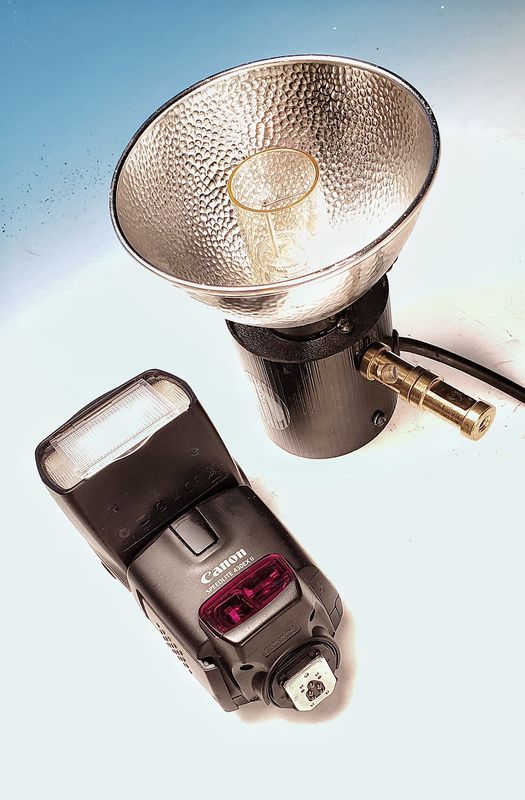
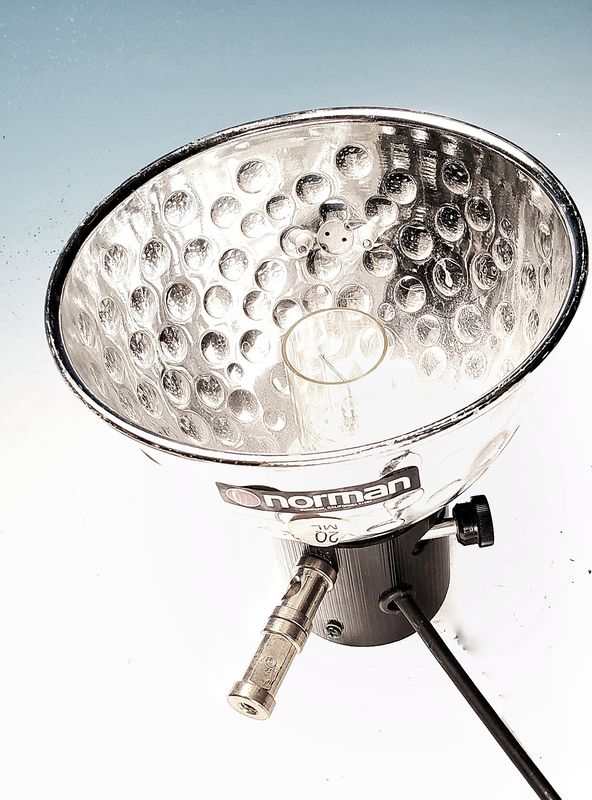
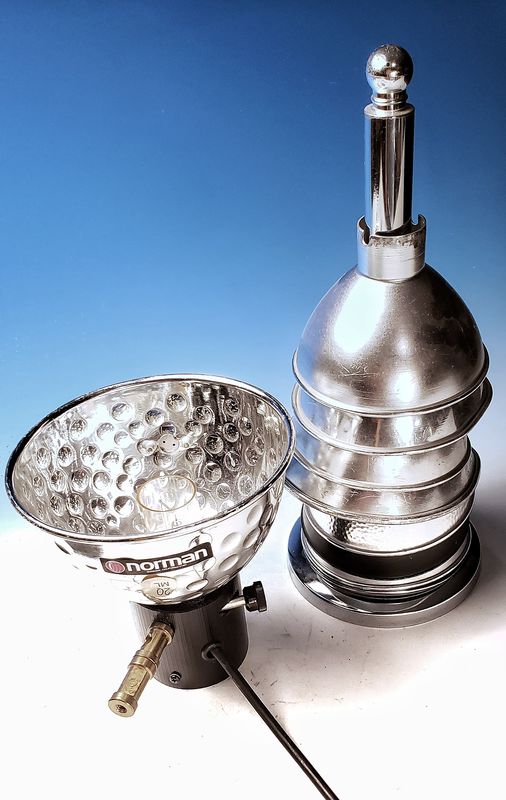
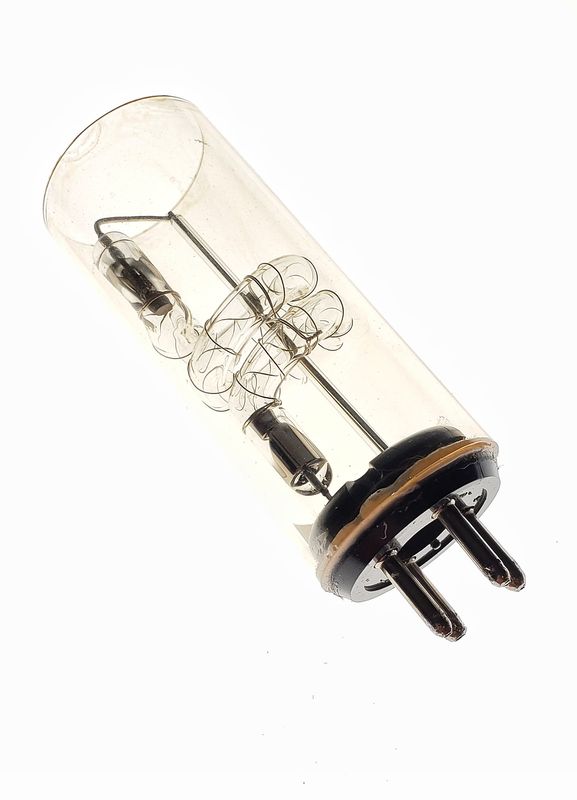
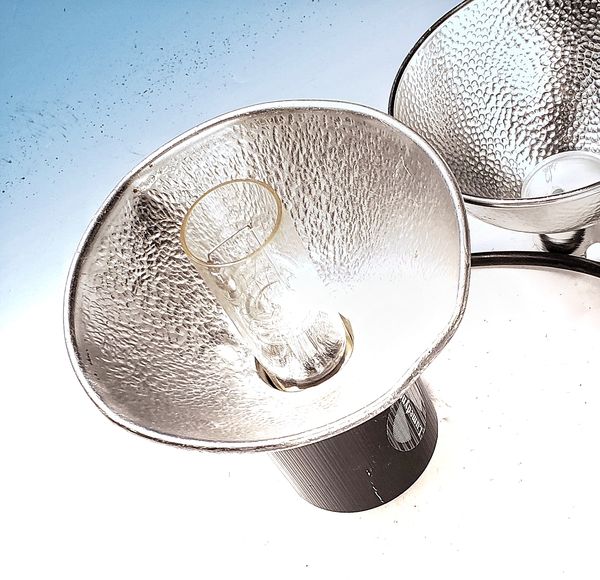
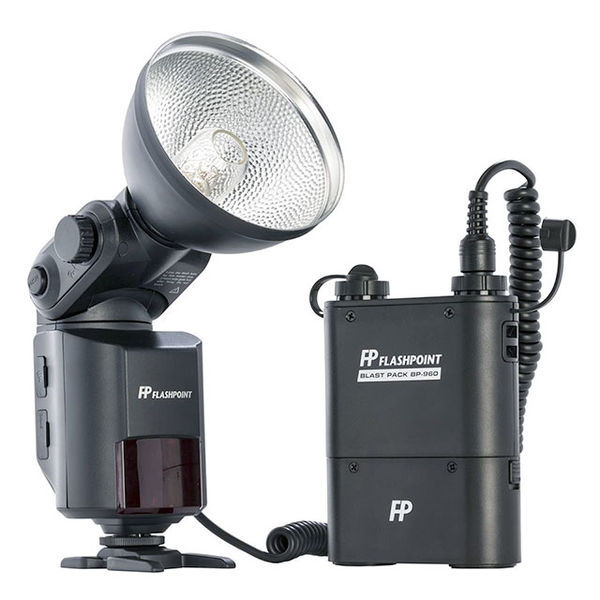
Aug 7, 2020 22:56:33 #
I want to play each and every one of you for your input, As I shoot AD 500 which does not have even a pop up Flash I've never really used one. Hence the next question what is a modifier I'm assuming it's a light Box umbrella some sort of form of reflective material To the fuse and/or bounce the light off of
Aug 8, 2020 00:14:01 #
dyximan wrote:
I want to play each and every one of you for your input, As I shoot AD 500 which does not have even a pop up Flash I've never really used one. Hence the next question what is a modifier I'm assuming it's a light Box umbrella some sort of form of reflective material To the fuse and/or bounce the light off of
This is what I use with my speedlights. The Kupo swivel umbrella bracket has a large clamping area that won't creep down from the leverage an umbrella exerts on it. I had a Manfrotto swivel umbrella bracket once. It had a small clamping area. No matter how tight I got the lock, it would still creep down from the leverage of the umbrella. The Kupo brackets won't do that. I would recommend getting an umbrella that has a pebbled silver interior surface. The silver interior will reflect more light than a white interior and the pebbled surface disperses the light more.
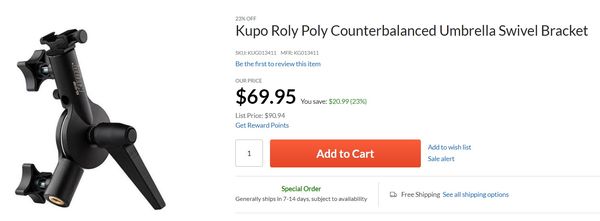
(Download)
The silver interior reflects more light and the pebbled surface disperses light better
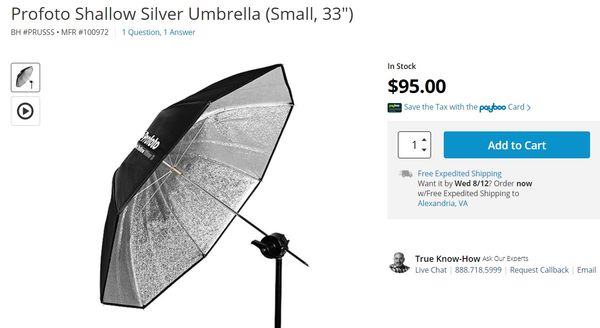
(Download)
Aug 8, 2020 05:23:34 #
Aug 8, 2020 07:00:58 #
Thomas902 wrote:
dyximan lots of very interesting and thoughtful re... (show quote)
Hi Thomas,
Beautiful photo. Did you mount 4 flashes onto an umbrella bracket, and the 72" parabolic was a reflective, not a shoot-thru umbrella? Thanks for explaining.
NMY
Aug 9, 2020 07:01:48 #
Harry0
Loc: Gardena, Cal
Segue!
I've just been getting ready to experiment on a dubiously somewhat similar subject.
I went thru storage- I still have some "fan" flash units that take bulbs- not many bulbs.
A friend of my wife's works the Riteaid counter. "Disposable" cameras usually are.
Kinda sad looking ones get the battery removed and tossed.I've got a dozen of these empties.
My big plan: I'll be working on taking the flash electronics out of these and installing that flash bulb into a used flash bulb. Some of the bigger ones can take two- maybe one sideways and one vertical, two in a line, etc. They won't be disposable bulbs anymore- flash all day! I won't need the insides anyway- that fat cap's been dead since LGJ, so they'll fit a pair or 3 of AAs.
The idea- is the idea. The conversion process looks cheap fast and easy. No old flash bulbs, socket rusted out? Replace with 1156 or 57 redone bulbs and new sockets. The circuitry is simple. That cute lil Tilt-a-Mite would look HOT on my D600! Rebuild, recycle modernize any old flash gun.
Once I use these up as a proof-of-concept, everything else is readily available. used and new Xenon tubes are avail and cheap. Heck, I could skip all that and run LEDs and a On/Off switch.
https://www.youtube.com/watch?v=N51Odq5lCNk
I've just been getting ready to experiment on a dubiously somewhat similar subject.
I went thru storage- I still have some "fan" flash units that take bulbs- not many bulbs.
A friend of my wife's works the Riteaid counter. "Disposable" cameras usually are.
Kinda sad looking ones get the battery removed and tossed.I've got a dozen of these empties.
My big plan: I'll be working on taking the flash electronics out of these and installing that flash bulb into a used flash bulb. Some of the bigger ones can take two- maybe one sideways and one vertical, two in a line, etc. They won't be disposable bulbs anymore- flash all day! I won't need the insides anyway- that fat cap's been dead since LGJ, so they'll fit a pair or 3 of AAs.
The idea- is the idea. The conversion process looks cheap fast and easy. No old flash bulbs, socket rusted out? Replace with 1156 or 57 redone bulbs and new sockets. The circuitry is simple. That cute lil Tilt-a-Mite would look HOT on my D600! Rebuild, recycle modernize any old flash gun.
Once I use these up as a proof-of-concept, everything else is readily available. used and new Xenon tubes are avail and cheap. Heck, I could skip all that and run LEDs and a On/Off switch.
https://www.youtube.com/watch?v=N51Odq5lCNk
If you want to reply, then register here. Registration is free and your account is created instantly, so you can post right away.




